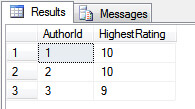By: Andy Brown | Comments (12) | Related: More > Scripts
Problem
If you're the sort of person who can effortlessly write complicated queries in SQL using a single SELECT statement, please click away from this article now! However, if ( like me ) your brain spins in proportion to the complexity of the query you're writing, read on to see how to use CTEs (Common Table Expressions) to break up complex queries into several distinct steps.
Solution
Let's start with a sample library database. I've deliberately kept this as simple as possible. It consists of just two tables:

Each author can have one or more books in the tblBook table, with the AuthorId column being used as a foreign key. If you want to reproduce this yourself, run this script:
-- create a database to hold OUR books CREATE DATABASE Library GO USE Library GO -- create a table of authors CREATE TABLE tblAuthor( AuthorId int PRIMARY KEY, FirstName varchar(50), LastName varchar(50) ) GO -- add some authors INSERT tblAuthor (AuthorId, FirstName, LastName) VALUES (1, 'John', 'Wyndham') INSERT tblAuthor (AuthorId, FirstName, LastName) VALUES (2, 'Barbara', 'Kingsolver') INSERT tblAuthor (AuthorId, FirstName, LastName) VALUES (3, 'Jane', 'Austen') -- create a table of books CREATE TABLE tblBook( BookId int PRIMARY KEY, BookName varchar(100), AuthorId int, Rating int ) -- add some books INSERT tblBook (BookId, BookName, AuthorId, Rating) VALUES (1, 'The Day of the Triffids', 1, 10) INSERT tblBook (BookId, BookName, AuthorId, Rating) VALUES (2, 'The Chrysalids', 1, 8) INSERT tblBook (BookId, BookName, AuthorId, Rating) VALUES (3, 'The Lacuna', 2, 10) INSERT tblBook (BookId, BookName, AuthorId, Rating) VALUES (4, 'The Poisonwood Bible', 2, 8) INSERT tblBook (BookId, BookName, AuthorId, Rating) VALUES (5, 'Pride and Prejudice', 3, 9)
You should now have 3 authors and 5 books.
A single-query solution
Suppose that you want to list out in alphabetical order the authors who have written more than 1 book. You could do this with a single query:
-- list authors who have written more than one book SELECT a.FirstName + ' ' + a.LastName AS Author, COUNT(*) AS 'Number of books' FROM tblAuthor AS a INNER JOIN tblBook AS b ON a.AuthorId=b.AuthorId GROUP BY a.FirstName + ' ' + a.LastName HAVING COUNT(*) > 1 ORDER BY Author
There's nothing wrong with this approach. Indeed for relatively simple queries like this one it's probably the best one, but as your queries get more complicated, it'll become ever harder to keep the whole picture in your head. The reason I like CTEs so much is that they allow you to break down a problem into different parts (always the holy grail in computing). To see how this works, we'll solve the above problem again - but more slowly.
A CTE solution
The following solution uses a common table expression, giving the following advantages:
- It avoids the need to repeat expressions in HAVING or GROUP BY clauses;
- It reads more logically and more intuitively.
To get things started, we need to get a list showing each author's id, together with the number of books they've written:
USE Library; -- list authors with the number of books they've written WITH cteBooksByAuthor AS ( SELECT AuthorId, COUNT(*) AS CountBooks FROM tblBook GROUP BY AuthorId ) -- use this CTE SELECT * FROM BooksByAuthor
Notice that the statement immediately before the CTE has to end with a semi-colon where I have "USE Library;", but this would be for any statement that is prior to the CTE.
What this query does is to create a temporary table-like object called cteBooksByAuthor, then immediately refers to it in the following statement. Note that CTEs are like cheese souffles: they can only be used as soon as they've been created. If we issued another query after this the CTE can no longer be referenced.
Now that you've created a CTE, we can join it - as for any other table - to another table to get at the authors' names. So our final query is:
USE Library; -- list authors with the number of books they've written WITH cteBooksByAuthor AS ( SELECT AuthorId, COUNT(*) AS CountBooks FROM tblBook GROUP BY AuthorId ) -- use this CTE to show authors who have written -- more than 1 book SELECT a.FirstName + ' ' + a.LastName AS Author, cte.CountBooks AS 'Number of books' FROM cteBooksByAuthor AS cte INNER JOIN tblAuthor AS a ON cte.AuthorId=a.AuthorId WHERE cte.CountBooks > 1
Not convinced? A slightly more complicated example ...
If the above doesn't convince you, consider this slightly more complicated query. Suppose that you want to show for each author their book with the highest rating. You could easily accomplish this with a single correlated subquery, but many SQL programmers will find it easy to break the task into two parts. First get a list for each author of their highest rating:

You can now link this to the books table, to get the books shown highlighted below:

Here's our CTE to return the right results:
USE Library GO -- get a "temporary table" (a CTE) of highest score for each author -- (don't need a semi-colon as this is now first statement in batch) WITH HighestRatings AS ( SELECT author.AuthorId, MAX(book.Rating) AS HighestRating FROM tblBook AS book INNER JOIN tblAuthor AS author ON book.AuthorId=author.AuthorId GROUP BY author.AuthorId ) -- get the name of book and name of author SELECT author.FirstName + ' ' + author.LastName AS Author, book.BookName AS Title, hr.HighestRating AS Rating FROM HighestRatings AS hr INNER JOIN tblBook AS book ON hr.HighestRating=book.Rating and hr.AuthorId=book.AuthorId INNER JOIN tblAuthor AS author ON book.AuthorId=author.AuthorId
This would return the following set of rows:

Whether you think that the CTE solution is easier to write is a matter for debate; but conceptually it is easier to read, I'd claim!
Next Steps
CTEs can do more than is shown above. You could try looking at one of these tips:
- Writing recursive CTEs (not for the faint-hearted ...)
- Consideration the relative speed of CTEs against other SQL methods of accessing data
About the author
 Andy Brown is a director of Wise Owl, a UK training company, and creator of many SQL Server blogs, tutorials and videos.
Andy Brown is a director of Wise Owl, a UK training company, and creator of many SQL Server blogs, tutorials and videos. This author pledges the content of this article is based on professional experience and not AI generated.
View all my tips






